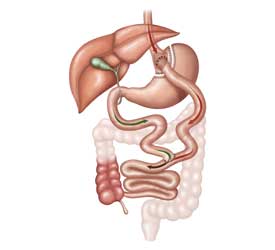 The gastric bypass operation looks complicated, but its essence is simple: The bypass works, in short, by helping patients feel “large-meal” satisfaction with very small meals.
The gastric bypass operation looks complicated, but its essence is simple: The bypass works, in short, by helping patients feel “large-meal” satisfaction with very small meals.
During the gastric bypass operation, the surgeon constructs for the patient a new, smaller stomach out of the top of the old one. This new stomach is called the “pouch,” and it is the most important part of the bypass operation; the rest of what goes on is just to give the pouch a way to empty. The job of the pouch is to provide the early arrival of the fullness that comes with eating.
When it’s made, a pouch holds about an ounce of food. Now, an ounce is a lot less than the patient’s stomach used to fit, since a normal human stomach holds more than a quart. After a bypass operation, the patient who used to be able to eat a very large meal will find that they now have much, much less room. When they sit down to dinner, they are going to have to fit their whole meal into a space not much bigger than a walnut. This walnut-sized stomach, however, still can deliver the normal full-stomach feeling. Even though the patient now only eats a few bites, if they eat those bites properly, they will leave that dinner table with the old “whole pizza” feeling.
With the bypass, malabsorption of calories does not contribute meaningfully to weight loss. There is decreased absorption of vitamins and minerals, but the malabsorption of calories is trivial, and it is not how the operation is designed to work; it works by making you want to eat less.
The gastric bypass is considered the “gold standard” of bariatric operations. Weight loss with the gastric bypass is the best of the restrictive surgeries. On average, excess weight loss peaks about 18 months after surgery and then settles at 70%.
The gastric bypass operation has been performed for more than 40 years for obesity, and it had been performed laparoscopically for the last 20. Patients are typically in the hospital for one or two days afterward.



